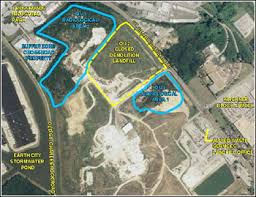
By John Stang
The U.S. Environmental Protection Agency has settled on a plan for cleanup of radiologically contaminated areas of the West Lake Landfill in Missouri, which it says will save a year of work and cost $30 million less than the previously anticipated approach.
Acting EPA Administrator Andrew Wheeler on Thursday signed the amended record of decision that calls for excavating down to 20 feet in the contaminated areas of the 200-acre Superfund site near St. Louis. The EPA predicts that the revised plan will cost $205 million and take three years to accomplish after on-site work begins.
“The improvements we’ve made in our final remedy will speed up construction time by a year and reduce exposure to the community and cleanup workers while still removing virtually the same total amount of radioactivity,” Wheeler said in an EPA news release.
The agency’s plan calls for digging out of radiologically impacted material greater than 52.9 picocuries per gram down to a depth of 12 feet in most cases, the news release said. Some excavations will go as deep as 20 feet. In select areas material with concentrations above 52.9 picocuries per gram will not be removed at depths of 8 to 12 feet.
The proposal issued in February was to excavate to the depth of 16 feet. The EPA at the time leaned toward a plan to remove 70 percent of the radioactivity from the two contaminated sites within what is known as Operable Unit 1 at the landfill, a portion of the larger West Lake Superfund Site that also encompasses the Bridgeton Landfill.
The plan rolled out Thursday is intended to remove significantly less noncontaminated soil — 61,000 cubic yards less — but roughly the same amount of radioactive materials. That is where the savings from the original $236 million estimate comes from, along with trimming a year off the excavation time, the agency said. The new plan calls for an 18-month design phase and three years of excavation. That will be followed by installation of an engineered cover over the landfill. The excavated material will be taken to an out-of-state disposal facility that has not yet been identified, St. Louis Public Radio reported.
“What’s always been the most important issue to me is making sure we have a safe, permanent solution that has the support of the local families in this community. That’s why I took the EPA to task for not having previously taken the input from the community seriously,” Sen. Claire McCaskill (D-Mo.), who had pressed legislatively for the U.S. Army Corps of Engineers to take over cleanup at West Lake, said in a prepared statement. “I am currently examining the details of the final proposal but at first glance this appears to be a significant step forward in achieving that goal.”
Two contaminated zones at the landfill hold 8,700 tons of leached barium sulfate dating to the Manhattan Project, which were mixed with 38,000 tons of soil for use in 1973 as cover for trash at the landfill. Local concerns about the radioactive contamination were exacerbated by an underground fire that has smoldered since at least 2010 at the adjoining Bridgeton Landfill.
West Lake’s groundwater was found to have unsafe levels of radioactive uranium, radium, and thorium-230 during tests from 2012 to 2014. The majority of the radioactive material is thorium-230, which is a decay product of uranium, which was processed at St. Louis’ Mallinckrodt Chemical Works facility during World War II.
The original record of decision from 2008 called for placing an engineered cover over the radiologically impacted areas, along with monitoring wells.
Bridgeton Landfill, LLC a subsidiary of waste disposal company Republic Services, owns the landfill and is one of the potentially responsible parties for cleanup, along with uranium processing company Cotter Corp. and the U.S. Department of Energy. “EPA will make every effort to reach an enforceable agreement with the PRPs to perform the cleanup work,” the agency said.
“Bridgeton Landfill, LLC is opposed to the selected excavation remedy because it creates unacceptable risk with no proportional benefit, will greatly increase the time needed to remediate the site, and is contrary to EPA’s own findings regarding the risks posed by the site. In 2008, EPA selected a cap and monitor remedy for the site, and EPA’s recent Proposed Record of Decision Amendment stated that the cap and monitor remedy is ‘protective of human health and the environment’ and would be ‘successful in reducing potential future risks from exposure to all contaminants at the Site,’” Republic Services said in a prepared statement.
The company characterized the EPA decision as “arbitrary and capricious.” It said it would “engage vigorously” with the EPA and other parties on the cleanup approach.
West Lake watchdog organization Just Moms STL praised the EPA’s decision.
“A remedy at this site was long overdue. While we are enthused that this site will finally be addressed and cleaned up, our attention is now set on securing relocation for those living closest, starting with (the area of Spanish Village. Viable relocation options must be available to residents before even one shovel sinks into this landfill,” said Just Moms co-founder Karen Nickel in a written statement.